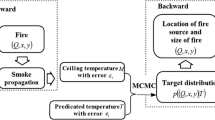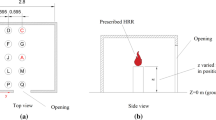Abstract
Thermocouples are often used to obtain gas temperature measurements in compartment fires. Such measurements are subject to a thermal lag during fire growth, but the main problem is a steady-state error induced by radiant heat transfer at the thermocouple surface. This error is sensitive to thermal parameters of the flame, compartment structure, thermocouple surface and combustion products; and is also influenced by the size and position of both the flame and thermocouple. The literature contains models of varying sophistication to enable an assessment of steady-state error. A model is now proposed that makes use of the concept of radiosity. Developed from radiant network theory, the model can be applied to both pre-flashover and post-flashover conditions. Experiments have been performed using different sizes of thermocouple and the models compared. The simpler models pre-date the more sophisticated and predict much larger errors than the latest published and current versions.
Similar content being viewed by others
References (Appendices)
C.L. Tien, K.Y. Lee, and A.J. Stretton, “Radiation Heat Transfer,” The SFPE Handbook of Fire Protection Engineering, 2nd ed., Section 1, 1995, pp. 65-79.
J.P. Holman, Heat Transfer, London: McGraw-Hill Book Co., 1997.
T.M.Yau, J. Francis, and G.M. Makhviladze, “Mass Burning Rate in Small-Scale Compartments with Different Linings,” in Proc. 3rd Int. Seminar onFire and Explosion Hazards, 2001, pp. 329-340.
T.M. Yau, T.L. Graham, and J. Francis, “Comparison of Flashover Model with Experiments,” in Proc. 9th Int. Conf. Fire Science and Engineering (Interflam 2001), vol. 2, 2001, pp. 1033–1045.
G.H. Markstein, “Radiative Properties of Plastic Fires,” in Proc. 17th Int. Symp. on Combustion, 1978, pp. 1053-1062.
H.Y. Wong, Handbook of Essential Formulae and Data on Heat Transfer for Engineers, Longman, 1977.
K.D. Steckler, J.G. Quintiere, and W.J. Rinkinen, “Flow Induced by Fire in a Compartment,” Nineteenth Symposium (International) on Combustion/The Combustion Institute, 1982, pp. 913-921.
K.I. Kim, H. Ohtani, and Y. Uehara, “Experimental Study on Oscillating Behaviour in a Small-Scale Compartment Fire,” Fire Safety Journal, vol. 20, 1993, pp. 377–384.
T.M. Yau, T.L. Graham, and J. Francis, “Comparison of Flashover Model with Experiments,” in Proc. 9th Int. Conf. Fire Science and Engineering (Interflam 2001), vol. 2, 2001, pp. 1033–1045.
K.D. Steckler, J.G. Quintiere, and W.J. Rinkinen, “Flow Induced by Fire in a Compartment,” in Proc. 19th Int. Symp. on Combustion, 1982, pp. 913-920.
M. Luo, “Effects of Radiation on Temperature Measurement in a Fire Environment,” Journal of Fire Sciences, vol. 15, 1997, pp. 443–461.
D. Gross and A.F. Robertson, “Experimental Fire in Enclosures,” in Proc. 10th Int. Symp. on Combustion, 1965, pp. 931-942.
J.G. Quintiere, B.J. McCaffrey, and K. Denbraven, “Experimental and Theoretical Analysis of Quasi-Steady Small-Scale Enclosure Fire,” in Proc. 17th Int. Symp. on Combustion, 1978, pp. 1125-1137.
K.M. Tu and V. Babrauskas, “The Calibration of a Burn Room for Fire Tests on Furnishings,” Report No Nbstn 981, Washington DC: USA National Bureau of Standards, Department of Commerce, 1978.
M.L. Bullen and P.H. Thomas, “Compartment Fires with Non-Cellulosic Fuels,” in Proc. Collq. on Fire and Explosions, The Combustion Institute/Factory Mutual Research Corporation, 1977, pp. 1139-1148.
H. Takeda, “Experimental Investigation of PMMA Compartment Fire,” Fire Science and Technology, vol. 5, 1985, pp. 11–20.
D.Yung, “Small-Scale Compartment Fire Experiments with PMMA Cribs,” Fire Safety Journal, vol. 17, 1991, pp. 301–313.
W.K. Chow and Y.S. Ng, “Experimental Studies of Compartment Fire,” Journal of Applied Fire Science, vol. 4, 1994, pp. 17–30.
N.A. Dembsey, P.J. Pagni, and R.B. Williamson, “Compartment Fire Near-Field Entrainment Measurements,” Fire Safety Journal, vol. 24, 1995, pp. 383–419.
C.M. Fleischmann and A.R. Parkes, “Effects ofVentilation on the Compartment Enhanced Mass Loss Rate,” in Proc. 5th Int. Symp. Fire Safety Science, 1997, pp. 415-426.
T.M.Yau, J. Francis, and G.M. Makhviladze, “Mass Burning Rate in Small-Scale Compartments with Different Linings,” in Proc. 3rd Int. Seminar on Fire and Explosion Hazards, 2001, pp. 329-340.
J.P. Holman, Experimental Methods for Engineers, McGraw-Hill, 1989.
L.G. Blevins and W.M. Pitts, “Modelling of Bare and Aspirated Thermocouples in Compartment Fire,” Fire Safety Journal, vol. 33, 1999, pp. 239–259.
J.A. Carvalho and W.F.N. Santos, “Radiation Errors in Temperature Measurements with Thermocouples in a Cylindrical Combustor,” Int. Comm. Heat Mass Transfer, vol. 17, 1990, pp. 663–673.
J.P. Holman, Heat Transfer, London: McGraw-Hill Book Co, 1997.
H.D. Baker, Temperature Measurement in Engineering, vol. 2, Stamford, Conn.: Omega Press (A Division of Omega Engineering Inc.), 1975.
H.Y.Wong, Handbook of Essential Formulae and Data on Heat Transfer for Engineers, London: Longman, 1977.
Author information
Authors and Affiliations
Rights and permissions
About this article
Cite this article
Francis, J., Yau, T. On Radiant Network Models of Thermocouple Error in Pre and Post Flashover Compartment Fires. Fire Technology 40, 277–294 (2004). https://doi.org/10.1023/B:FIRE.0000026974.18642.a1
Issue Date:
DOI: https://doi.org/10.1023/B:FIRE.0000026974.18642.a1




